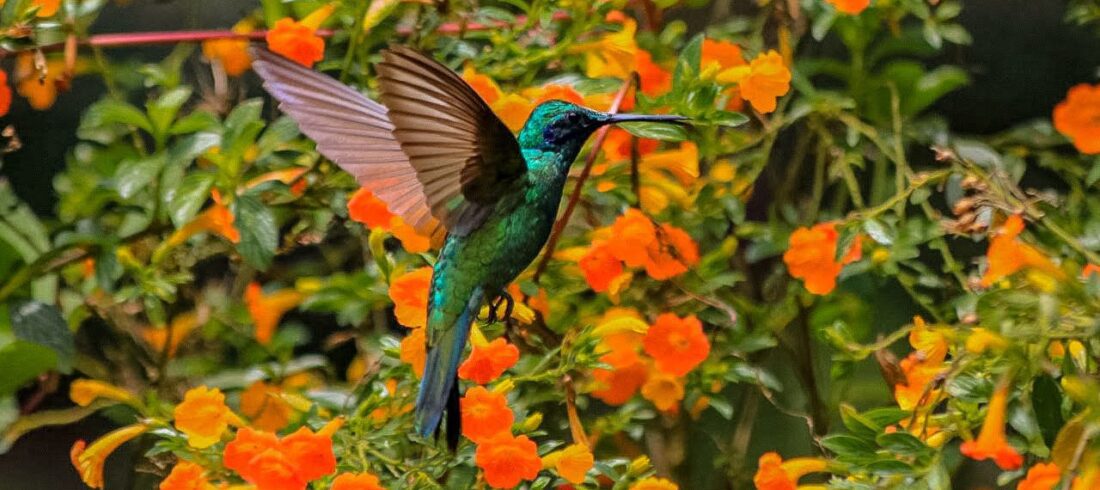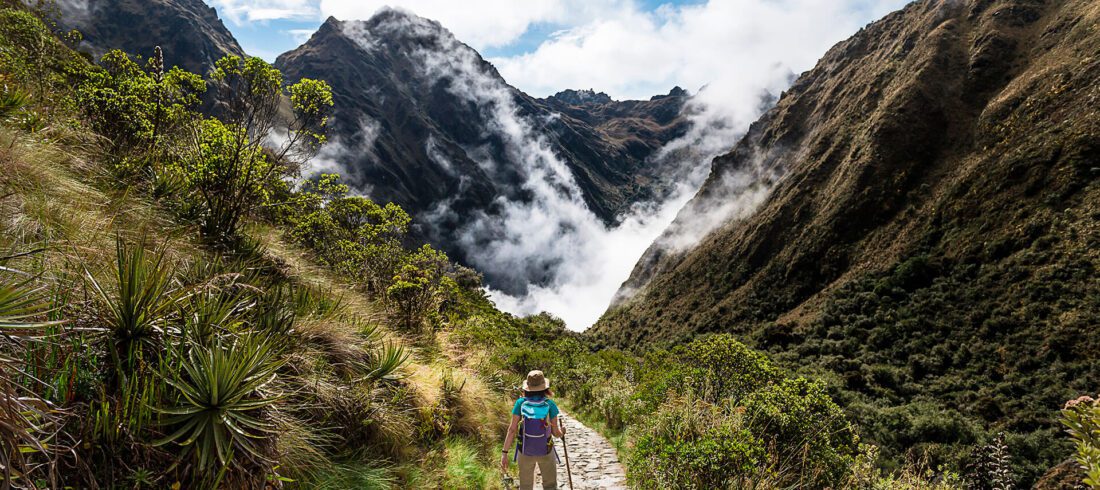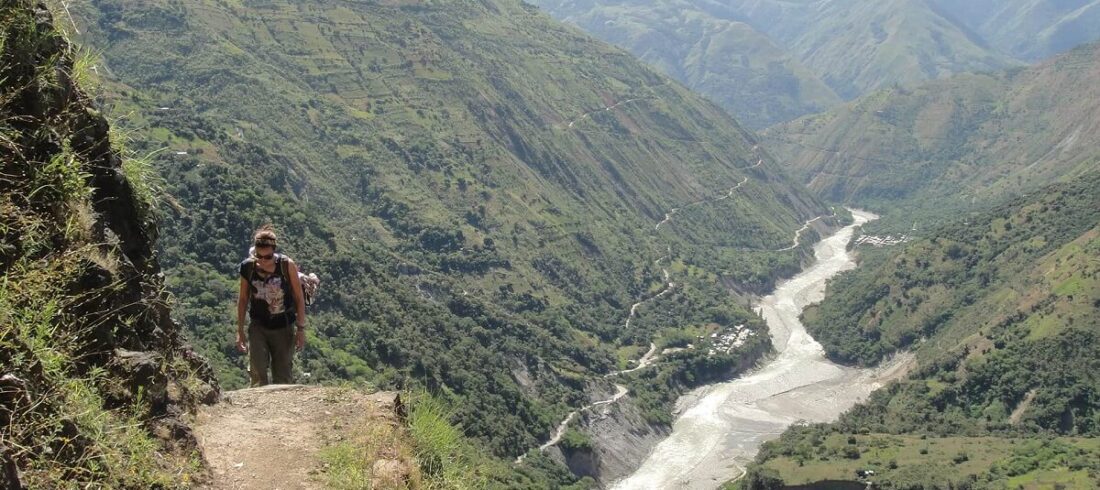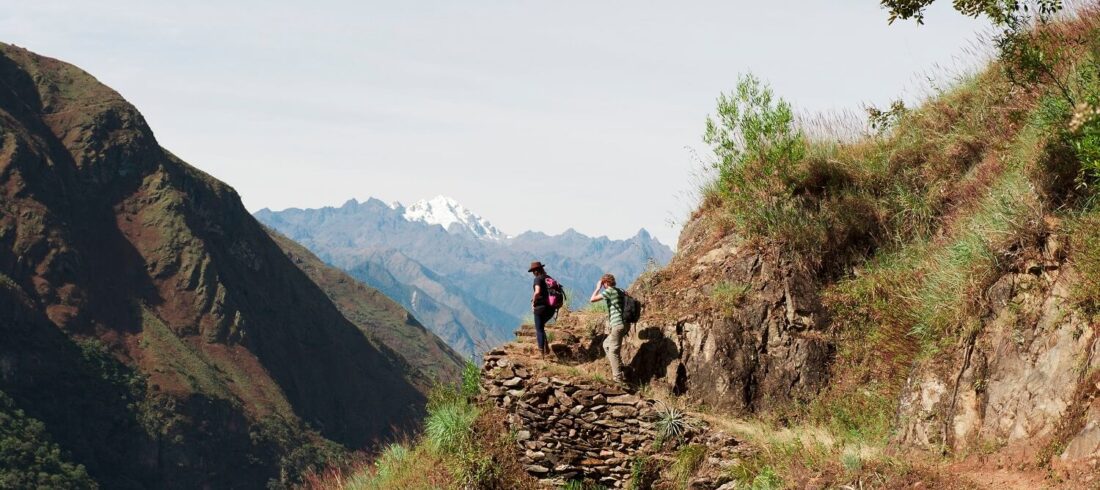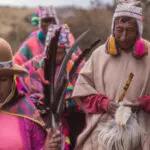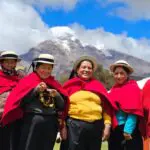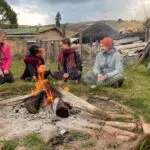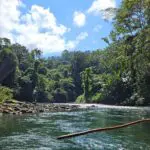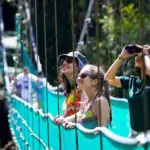Table of Content:
Preparations for visiting Machu Picchu in 2024
Machu Picchu is, with almost 100% confidence, the biggest highlight of any visit to Peru.
It is, of course, only part of the big picture, but certainly an important one. So, you don’t want to risk experiencing the stress many travelers can deal with when not preparing for this part of their trip well enough.
News runs worldwide very fast when something happens in Machu Picchu; unfortunately, the news is only sometimes pleasant.
They might show long lines of people waiting to board the buses covering the distance between the town and the citadel or to enter it. Strikes might be organized by any of the many groups involved in the activities surrounding the site. And last but not least, the forces of nature can impede access to this remote area.
Some of these contingencies can be solved, but others, of force majeure, can’t. Here we will concentrate on the ones that can be dealt with.
Tip #1 Plan your Machu Picchu visit outside of the rainy season
Rain is a blessing, but if you only count on one day to pay a visit to a wonder like Machu Picchu, you want to experience the epitome of the Incan architecture and not the downpour of rain.
When visiting the Andes and the Peruvian jungle (and Machu Picchu, which is in its transition zone), it is better to avoid the rainy season because floods and landslides can occur at any moment, blocking roads or cutting bridges, thus making traffic impossible.
The dry season roughly comprehends the period from April to November. Actually, in this region, rain can come at any moment, but with much less intensity and duration than in the off-season.
Tip #2 Buy your Machu Picchu tickets in advance
A visit to Machu Picchu normally involves trains, buses, hotels, and entry to the site of course.
The order of priority you should give to buying the respective tickets is more or less like this: Machu Picchu ticket, train tickets, hotel reservation, and bus tickets.
Consider buying your Machu Picchu tickets at least 3 months in advance, preferably 6 (or even 9, if you plan to trek the Inca Trail).
The only limitation to this recommendation is the availability of Machu Picchu entry tickets, which are not open for purchase for all future dates. For example, tickets for 2025 are not yet on sale, as they will be released gradually at the discretion of the authorities when deemed appropriate.
Tip #3 If you are not planning it yourself, leave it in the hands of experts
This is probably the best recommendation we can give you, not because we want you to buy our services, but because many travelers are scammed by unscrupulous “agencies” that tell lies to passengers promising things that can’t be done. Like getting you last-minute tickets or promising a backdoor way into Machu Picchu.
An easygoing trip to Machu Picchu requires logistics that not everybody can see in its full complexity. Not to mention that daily visits to this wonder are limited according to the maximum capacity of the site to safeguard the citadel from overtourism.
Our VERY SPECIAL Tips for Visiting Machu Picchu’s side-attractions
Before doing the tour around the citadel, it’s possible to visit the very interesting Inca Bridge. Please reserve your visit to the Inca Bridge in advance as it is a different kind of ticket. Additional note: It’s still not possible to visit the Sun Gate, except if you book the Inca Trail.
The standard guided tour of Machu Picchu typically spans two to three hours. However, if you wish to ascend Machu Picchu Mountain and are concerned about fatigue—especially if you’re not particularly active—we suggest tackling the mountain climb first. This ascent takes about three to four hours. Afterward, you can enjoy the tour at your own pace, ensuring a more comfortable and fulfilling experience.
For the active travelers, our tip is to climb Machu Picchu Mountain, instead of the crowded Huayna Picchu, and to do this after the citadel tour. Machu Picchu Mountain is slightly higher (a climb of about one to one and a half hours), but it offers a magnificent view over Machu Picchu, Huayna Picchu, and the Urubamba River below. Plus, the path and nature along the way are beautiful, and since it’s less visited, it feels like an escape from the crowds of Machu Picchu.
Note that you must decide in advance if you want to do the climb, as it requires a different entrance ticket which has assigned time slots and comes with additional charges. Climbing Machu Picchu Mountain doesn’t require a guide.
If you want to climb Machu Picchu Mountain, keep in mind that the mountain’s entrance is only open at two times: between 7 and 8 o’clock and between 9 and 10 o’clock. The start time indicated in your ticket is also the time you can enter Machu Picchu, an for instance Machu Picchu Mountain, not earlier.
Best Ways to Get to Machu Picchu
Get Tickets for the Inca Trail – Be quick!
Every day, a maximum of 500 people can walk the Inca Trail. You have to book even earlier to secure a ticket. Especially during our summer months, you need to arrange this at least 6 months before departure. Tickets for the Inca Trail are regulated by the government. Everything is personal and in the name of the tourist. Once it’s full, it’s full!
Many people who visit Machu Picchu do so via the multi-day Inca Trail. The number of permits for this hike is limited, and the four-day trek is often sold out months in advance. Fortunately, there are great alternatives that don’t require booking so far in advance.
The Coffee Route
The Coffee Route is a trek of, your choice, two, three or four days, starting from the Sacred Valley and ending at the foot of Machu Picchu. Along the way, you partly rely on public transportation, but primarily walk over ancient Inca steps, visit organic coffee, cocoa and tea plantations, learn about the production processes, sleep with hospitable families, and experience life in the countryside. The host families are proud of their plantations and are keen to show you around. It’s a wonderful way to get to know Peru authentically.
The Salkantay Trek
Another alternative to the Inca Trail is the Salkantay Trek. This trek is slightly cheaper than the Inca Trail and doesn’t need to be booked as far in advance, but it is quite challenging. Over five days, you cover about eighty kilometers, reaching a high point of 4600 meters. The rewards are great, though, as the mountain landscapes are stunning and incredibly varied: you walk past snow-capped peaks as well as through rainforest and by waterfalls. The Salkantay Trek is known as one of the most beautiful trekking routes in the world and is an excellent alternative to the Inca Trail. Just be aware that this trek also attracts many other hikers. If you’re looking for a trekking route that’s off the beaten path, our travel expert can surely help you with this.
Types of tickets for Machu Picchu
Only delve into this section if you’re deeply interested in understanding every detail of the Machu Picchu tickets. Otherwise, feel free to skip ahead to the next section, which covers the various circuits within Machu Picchu.
- Llaqta de Machupicchu (Circuito 1 & 2): this is the classic visit to the citadel (or ‘llacta’) where you can take any (but only one) of the two first circuits designed by the authorities of the site. Chances of getting tickets for this route might be higher because there is more availability (but this is not a rule!).
- Circuito 4 + Montaña Waynapicchu: this is the most popular alternative for adventurers, including access to the mountain (Waynapicchu, the one portrayed in almost every picture of Machu Picchu). But this ticket only allows the use of circuit 4 along the citadel. Tickets for this route are more expensive and more scarce. Morning admission only.
- Montaña Machupicchu + Circuito 3: this is the second most popular alternative, including access to the opposite mountain (also called Machupicchu). This ticket only allows the use of circuit 3 along the citadel. More expensive and fewer tickets than the classic visit (the same price as the one to Waynapicchu mountain but its availability is doubled), although very restricted entrance times.
- Circuito 4 + Montaña Huchuypicchu: this should be the last option to consider when visiting Machu Picchu because it does not offer a significantly different experience. BUT, in situations where tickets to the previous routes are lacking, this can be a lifesaver.
- Circuito 1 or 2 + Puente Inca: this is the visit we talked about before when giving you our special tips considering side attractions.
There is also the so-called Circuit 5, which intended for those who did the Inka Trail (in any of its versions: 4-day, 2-day, 5-day, 7-day). We only offer the 4-day Inca Trail version for practical reasons, but you can check the other options with our partner agency.
Sales: starting gradually since October
Price: variable depending on the version
Seasonal admittance: closed during all of February
IMPORTANT: Machu Picchu tickets do not allow changes of name or date, only the ID number in case you obtained a new document before coming to Peru.
Circuits inside Machu Picchu
All five circuits are one-way only and were designed to protect the citadel from overuse and make crowds flow along the passages without much hassle.
Each of them has an estimated time for completion, as well as pros and cons (according to us), as explained in the following lines.
Circuit 1
2-hour experience
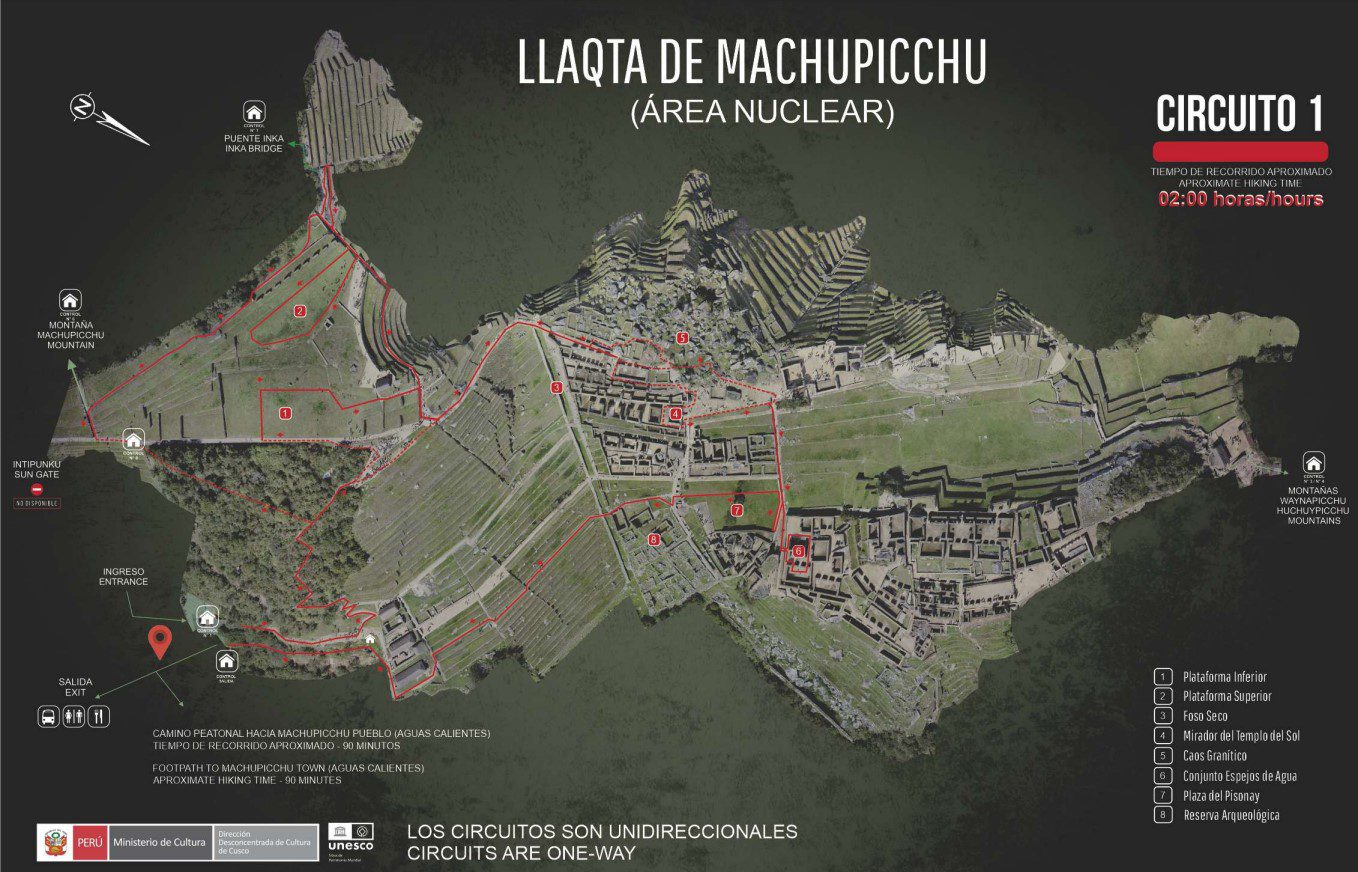
Pros
- Gives access to the classic lookout point for great scenic views.
- Great during the less-visited times (afternoon time slots).
Cons
- It doesn’t give access to almost half of the complex, where the Sacred Plaza, the Intiwatana Pyramid, the Sacred Rock, the Three Gates, and the Condor Temple are located.
Circuit 2
3-hour experience
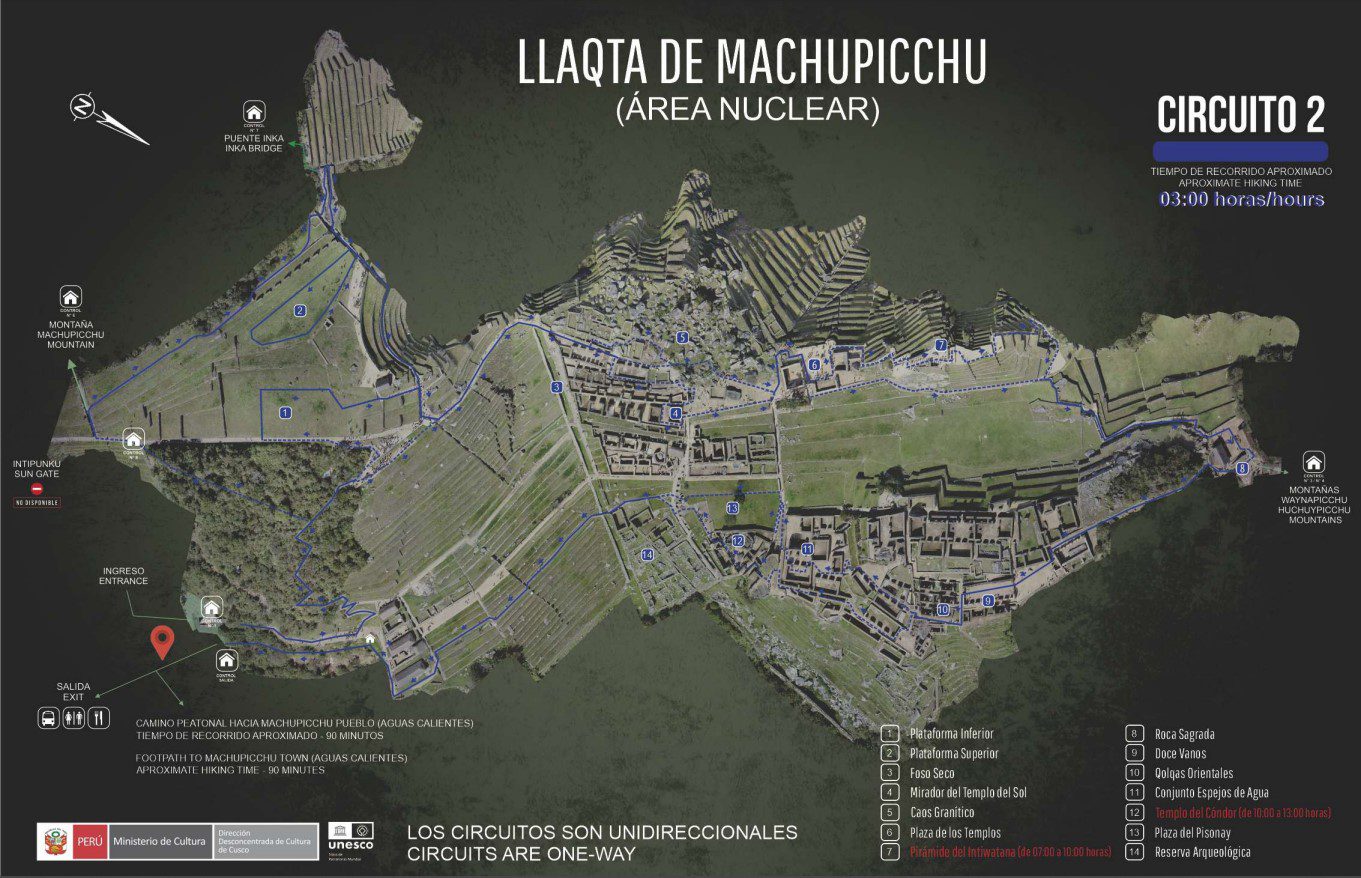
Probably the best circuit of all
Pros
- Gives access to the classic lookout point for great scenic views.
- Great during the less-visited times (afternoon time slots).
Cons
- Limited access to Intiwatana Pyramid (considered a monument inside the citadel)
- Limited access to the Temple of the Condor (considered a monument inside the citadel)
The following map is to give you context for the next two circuits (3 and 4)
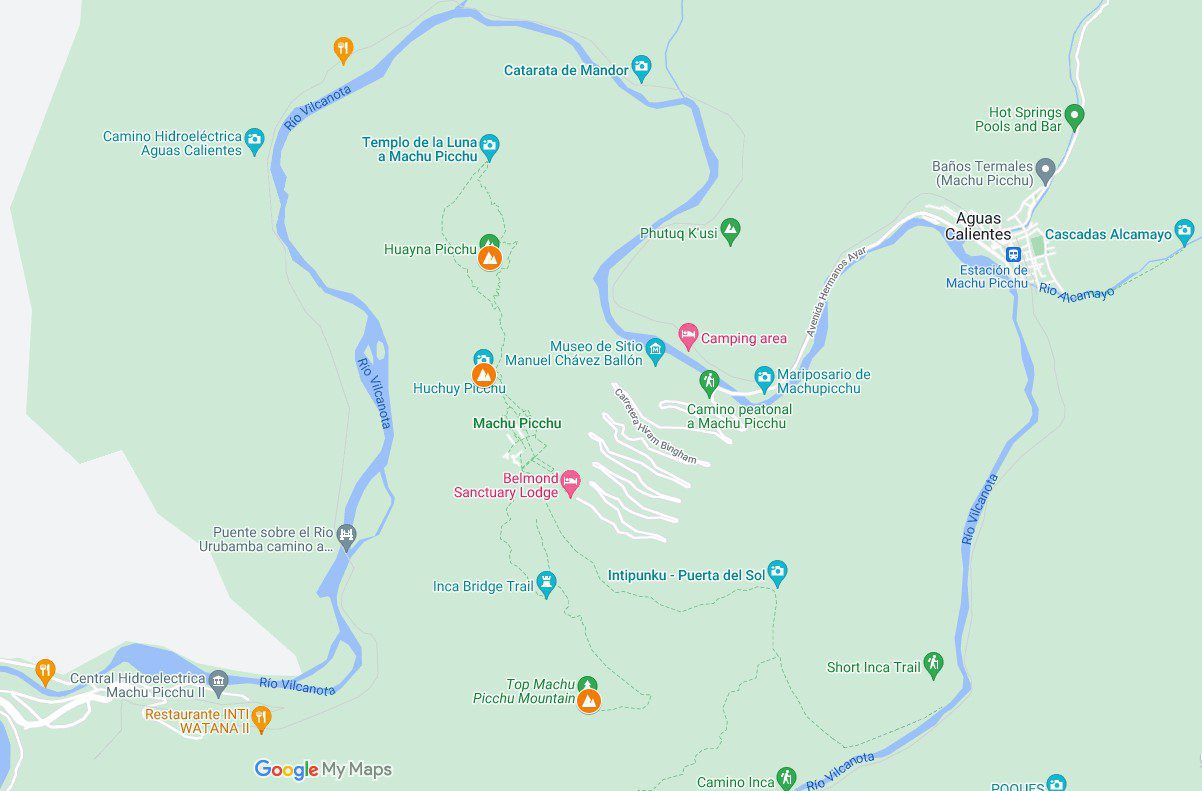
Circuit 3
1.5-hour experience
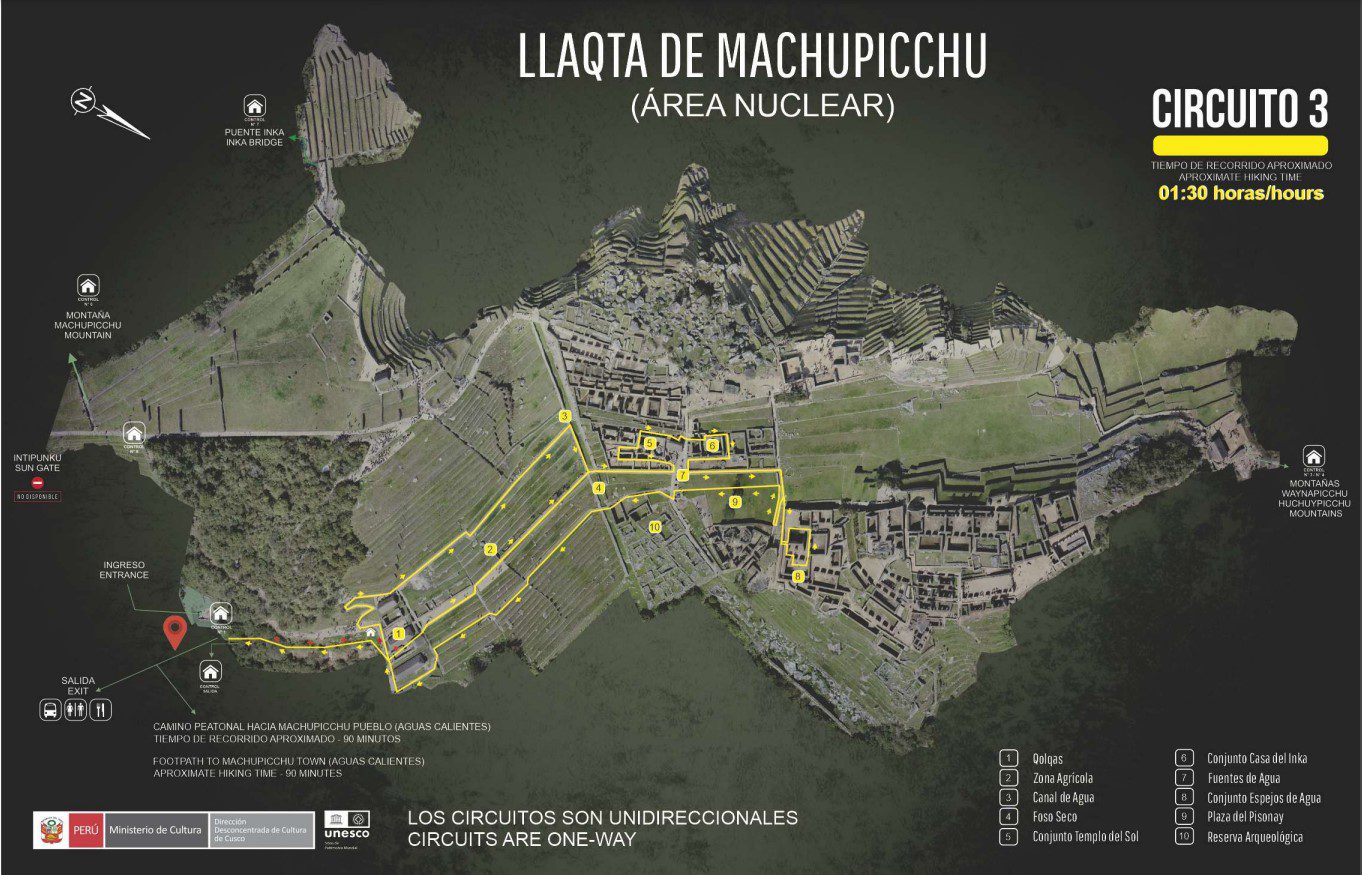
Circuit 3 is the only circuit you are allowed to take if you bought a ticket to climb Montaña Machupicchu
Pros
- This is a circuit designed for people with reduced motricity (and/or using wheelchairs). There is no need to climb or descend much.
- Access to the Sun Temple complex (considered a monument inside the citadel).
Cons
- Very limited: it doesn’t give access to the classic lookout point nor many other monuments of the site. And you won’t pass through the Main Gate (very popular among visitors).
Circuit 4
2.5-hour experience

Circuit 4 is the only circuit you are allowed to take if you bought a ticket to climb Waynapicchu or Huchuypicchu mountains.
Pros
- Good for those who cannot (or don’t want to) climb a lot but still want to have a more or less comprehensive visit to the citadel.
- Gives access to the Sun Temple complex (considered a monument inside the citadel).
Cons
- It doesn’t give access to the classic lookout point, and you won’t pass through the Main Gate (very popular among visitors).
- Limited access to the Temple of the Condor (considered a monument inside the citadel)
Circuit 5
Accessible when buying any of the ‘Inka trail’ tickets
1:30-hour experience
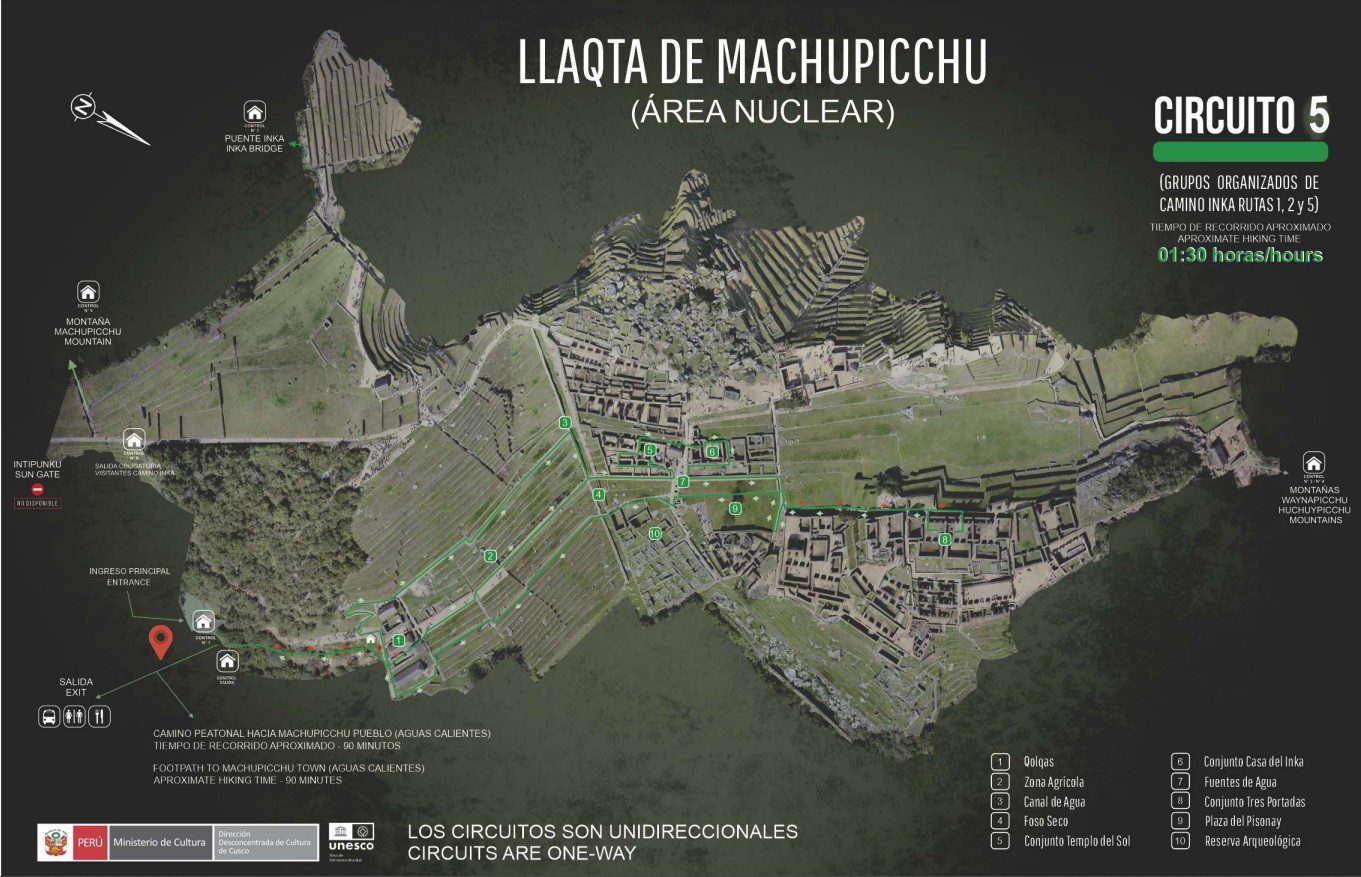
Trekking the Inka Trail will get you to Machu Picchu in the early morning hours after entering through the Intipunku or Sun Gate (see the left edge on the map).
At the next control point, you will be asked to choose if you stay and take the circuit or leave momentarily (if you want to use the restroom) and re-access later.
Pros
- Gives access to the Sun Temple complex (considered a monument inside the citadel).
Cons
- Doesn’t give access to the classic lookout point.
What to bring on your Machu Picchu visit?
- The ID that you bought your tickets with! Without your passport or other ID, with the number that matches the one on your entrance ticket, you will not be allowed inside.
- Good shoes. Consider that there could be mud and/or wet rocks and that you also want your ankles to have good support during your walk or climb to some of the mountains.
- If it’s the rainy season (November-April), there will most likely be some precipitation, and even if it’s not the rainy season, you want to be alert. You never know when there will be wet conditions, therefore you will want to bring a light or heavy raincoat.
- If you NEED a walking stick, it must always have a rubber tip.
- Solar protection: everything you find to be necessary and enough, along with sunscreen (hat/cap, sunglasses, long sleeves and pants, others)
- Hydration for the maximum length of the visit (3 hours tops) and snacks in reusable or eco-friendly containers/packaging.
- Small personal backpack
Official rules to Visit Machu Picchu
During your visit to Machu Picchu, it is prohibited to:
- Carry backpacks, bags, or purses larger than 40x35x20 cm (16x14x8 inches).
- Enter with food or kitchenware, i.e., plates, cutlery, thermoses, etc.
- Enter with any illegal substance or be under the influence of any substance.
- Enter with any alcohol or under its influence.
- Enter with umbrellas, walking sticks (with few exceptions, only if you can’t walk without them), portable chairs, tripods, monopods, selfie sticks, or other photography/film stabilization accessories.
- Enter with animals, except guide dogs.
- Feed domestic or wild animals.
- Enter with any aerosol.
- Deface, alter the ruins, or leave any graffiti on them.
- Enter with any musical instrument, megaphone, or speaker.
- Make loud or disturbing noises (scream, whistle, clap, sing, etc).
- Use virtual apps in narrow paths or outside designated explanation areas.
- Enter with heels or hard-sole shoes.
- Access with baby strollers.
- Enter with knives or weapons of any kind.
- Enter with banners, posters, or other objects of this type, clothing intended for advertising purposes, and costumes, among others.
- Film or photograph for advertising purposes.
- Generate turmoil, undress, lie down, run, and/or jump.
- Climb or lean on walls and/or structures. Touch, extract, or move lithic elements such as rocks and stonework.
- Disturb, collect, or remove flora or fauna.
- Carry out activities that distort the sacredness of the monument; such as fashion shows, dances, social commitments, obscene acts contrary to morality and good manners, and perform any kind of activity that implies the impairment or deterioration of the monument, its natural environment and/or facilities.
- Smoke or vape, or start a fire of any kind.
- Litter.
- Stray from the established circuits/routes.
- Sell or trade inside the monument and surrounding areas, until Puente Ruinas.
- Fly over with paragliders, drones or any type of craft.
Performing acts or entering with objects prohibited in this list will generate the immediate expulsion of the visitor without reimbursement and the start of legal actions if necessary. The park guards of the Ministry of Culture and the agents of the National Police are the authority within the monument’s premises.
What is next?
Buy your train tickets / Book accommodation / Get bus tickets
Or if you prefer, let us plan your trip!
